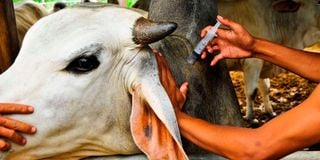Yes, Kenya can be free of foot and mouth disease

A cow getting vaccinated. With goodwill, Kenya has all it takes to plan and achieve the same success as Botswana in eradicating foot and mouth disease.
Kenya is known for developing very good systems and products, then abandoning the initial objective and being overtaken by countries that copied from her.
The country started off very well in animal diseases control and attained eradication of the deadly rinderpest, along with other nations.
But in the control of foot and mouth disease (FMD), the initial tempo dissipated and all gains were lost. The disease flared up, and today, FMD is present in every county in the country. Multiple outbreaks occur each year without fail.
The result of the nation’s failure to control FMD to the level of being declared FMD free is denial of meat trade with the lucrative European and other external markets.
FMD is one of the most trade-sensitive livestock diseases because of its ability to infect cattle, causing death, long-term body deterioration and loss of current and future production.
Countries with good FMD control, therefore, do not trade in livestock and livestock products with nations having poor or no control of the disease.
Botswana is one country in Africa that has stood out tall in the control of FMD. It has been well-rewarded with special meat trade relations with the European market that Kenya yearns for without doing much to interest the market.
The story of Botswana is interesting because a large part of the workforce that established the Botswana meat industry were former employees of the Kenya Meat Commission.
Second, the former Chief Veterinary Officer of Botswana, Dr Modisa, who presided over the FMD elimination in the country was trained in Kenya as a veterinary doctor. He was my classmate at the University of Nairobi from 1984 to 1988.
Modisa confirms that he was very well-trained in Kenya. Later, he came back to the country, studied the disease control protocols, then in place, and went back to implement the same in his country. Of course, back home they modified the protocols and improved them to fit the Botswana situation.
The success has been loud and clear. Interestingly, many Kenyan disease control teams have been trooping to Botswana repeatedly to benchmark on the country’s success; unaware that Kenya has all it takes to plan and achieve the same success.
Last week, Modisa, who is now retired from public service and manages his own farm, was the chief guest at an FMD public participation meeting in Nairobi, hosted by the Kenya Director of Veterinary Services.
I was invited to the meeting to share my experiences on the contribution of private veterinary service providers in FMD control.
The meeting sought to engage various stakeholders in the development of the National Foot and Mouth Disease Strategic Plan. Modisa’s role was to detail Kenyans on how Botswana has managed to attain an FMD-free status.
Other key speakers in the meeting included Dr. Njogu of the Directorate of Veterinary Services. He presented results of research on the status of FMD in Kenya.
The country has the disease in plenty, inadequate control measures and no specific strategy for eradication.
The Kenya Veterinary Vaccines Production Institute (KEVEVAPI) was represented by its acting Managing Director, Dr Alex Sabuni.
He explained that the institute produced FMD and other disease vaccines, but uptake by the farmers was poor resulting in the costly expiry of millions of doses of the FMD vaccine.
The meeting also heard that buffaloes, goats and pastoral cattle were mainly responsible for FMD maintenance and outbreaks in the country.
The culprit cattle and goats were those locally resident and incursions from neighbouring countries, especially during the droughts and dry seasons.
Modisa explained the Botswana FMD challenge was very similar to that of Kenya as all the culprit animals mentioned were also in plenty in his country.
He said Botswana realised that cattle were the mainstay of its rural economy and had the potential to greatly enhance the country’s economy if FMD and other trade-sensitive diseases were eradicated.
Since the early 90’s, Botswana embarked on a programme to eradicate FMD. They realised they needed strong top national political goodwill, a strong and dedicated technical team, education of farmers and cattle industry players and a lot of transparency with external beef trading partners.
The Botswana national leadership gave strong support to the FMD eradication programme, provided resources and did not politicise FMD control activities.
It left the technical team headed by the Chief Veterinary Officer to implement the activities and monitored the outcomes.
In 2017, Botswana drew up an FMD eradication strategy to have the country declared free of FMD with vaccination by 2025.
The country has since achieved that status. Modisa concluded if Kenya emulated Botswana’s FMD eradication journey, she would surely attain FMD-free status with vaccination. Due to the presence of buffaloes in Kenya, it would be unrealistic to target an FMD-free status without vaccination.





